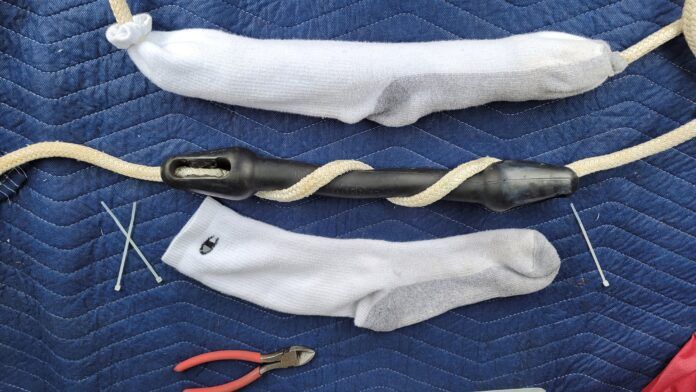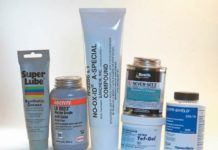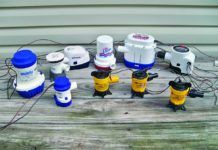
Point me to any boat, anywhere, anytime and I can guarantee you I will find a few tricks or particular set-ups made by its owner and crew to make their tasks onboard easier and/or more efficient.
Every time I’m around boats, whether at my own yacht club or other clubs and marinas I visit during my travels, I look for how boats have been set up and evaluate or think about how these improve the overall care and handling of the boat. Naturally, I then think about how these ideas could apply to my own boat.
So here are some of the best practices I’ve applied. Some are stolen and some are original!
MOORING LINE SHOCK ABSORBER PROTECTORS
As the name implies, these smart black rubber devices do exactly that. They absorb shock and relieve tension, protecting not only the boat, but also the lines themselves from wear and tear and damage. But they can also leave their mark on your boat.

Because they are constantly exposed to the weather and sun, they can degrade and start leaving black marks and scuffs on your boat’s finish. Of course, you can install them closer towards the dock to resolve that issue. But what about protecting them from the weather? To solve that problem, I use thick, long gym socks to cover the shock absorbers. Installed loosely, with tie-wraps, they allow the shock absorbers to expand and contract all the while protecting them from the elements and from marking the boat.
White gym socks will also not stain your boat’s finish like colored sleeves sold mostly for fender covers, which I threw out as the dye used to color these covers kept staining my hull. Unfortunately, I have not yet found gym socks big enough to cover my fenders.
IMPROVED BOAT HOOK MANAGEMENT

Did you ever see a boat hook fall in the water and see it either sink straight away or float just a few inches below the water’s surface for a few seconds before heading to the bottom? I have a few times in my 40-plus years of boating and, oddly enough, it was never at a good time.
Other issues with boat hooks:
- They are often stored away and not readily at hand when you need them quickly.
- There is only one available when two would have been better.
- Once extended, they often collapse just as you’re trying to fend off another boat, dock or seawall, etc.
- After a while the twist’n’lock function to expand or contract the length just stops working, leaving you twisting with no results, again never at the right time.
- Sometimes, it becomes impossible to unlock the twist’n’lock mechanism, especially in a salt water environment.
- The better ones now have expansion lock systems and claim to float long enough to recover them, but are expensive.
- Most keep and last long in a fresh water environment but do poorly in a salt water environment, requiring to be replaced more frequently.
So, what is the solution?
Buy a Better One. One is that you can just go out and buy the best of the best like Eversprout, Sanlike, etc. Many now have locking type extensions in lieu of the forever failing twist’n’lock system. Some claim to float for a while giving you enough time to recover it. However, from personal experience, most float for a little while before going down.

Painter’s Extension Pole. For one of my primary boat hooks, I use a painter’s extension pole. With a very visible yellow main fiberglass shell and an easily adjustable/lockable aluminum extension insert, it is super resistant to any wet environment. The main fiberglass shell has a molded handle at the end with no holes on the end, therefore capturing air inside the shell. This alone allows the whole thing to float (at the surface) for a long time. When I tested mine, I extended it fully and attached a thin light tether line and dropped the whole thing in the water. After 30 minutes, it was still floating at the surface. Its yellow fiberglass shell is very visible from a distance. I still wonder how long it would have floated, but 30 minutes was more than enough time!
To make use of my old boat hook, which lasted maybe three years before its twist’n’lock mechanism stopped working, I set it to a specific length and used three aluminum self-tapping screws to permanently lock it.
Every experienced boater knows that boat hooks need to be where they are needed most and easily accessible. Stored deep inside a locker or in the cabin may not be the best location for a quick retrieval. They also need to be out of the way when not in use.

Also, in my humble opinion, any boat between 18 ft. and 30 ft. should have at least two boat hooks on hand and all passengers should know where they are so they can quickly assist in fending off an incoming collision.
On my 27-footer, I have three boat hooks. The fiberglass painter pole is close to the bow on quick-release stanchion mounts by Victory. Another one is on the stern near the helm in a support I made out of 1 ½-in. water pipe and zip-ties. That’s the one I locked in with the three self-tapping screws. I have a third extendable one in the cockpit locker as a spare and for using on the tender. That one still works, although during the first use, the rubber handle on the end flew off the first time I retracted the extensions (it did not float!).
PRACTICAL FENDER USE AND CARE

I can already hear many of you yelling out “Land Lubber!” But let’s be fair, many of us who go out for a few hours find it a pain to remove and store fenders just to have to pull and install them back again.
When leaving for a few days and planning to be at anchor most of the time or if you have extra deck hands and adequate storage, then storing them makes more sense.
In my case, I simply hate having to handle the fenders every time I go out. When I do, I don’t have locker space to accommodate all six fenders and I don’t want to have them in the cabin, taking up space. Also, I often head out alone, so handling fenders is not on my to-do list.
But, having said that, I also hate it when my fenders bounce and splash around when heeling. So instead of working hard, I choose to work smart, by tying the bottom of the fenders together to a tether line that leads to the aft most cleats near the helm. I can raise or deploy them right from the helm! Bingo, problem solved.
As for taking care of them, again, I prefer to work smart and not too hard. Every season, while they are hanging low, I generously spray them with automotive tire treatment. I let that soak in for 15-20 minutes and then wipe the excess off with a microfiber towel. And that’s it! Really clean and also provides them with a protective coating. It also works on any color fender!





































Where can I buy a boat hook end to screw onto a painters stick?
Amazon or your local boat store.
Boat Hooks for Docking Telescoping Boat Hook Pole Push Pole for Boat Docking Stick Boat Hook Adapters Screw End 3/4″ Thread Boating Accessories Marine Push Dock Stick Pontoon (Hook Only or with Pole) https://a.co/d/ccbfken
I also would like to a boat hook end that would screw into the painters rod.
Amazon or your local boat store
Boat Hooks for Docking Telescoping Boat Hook Pole Push Pole for Boat Docking Stick Boat Hook Adapters Screw End 3/4″ Thread Boating Accessories Marine Push Dock Stick Pontoon (Hook Only or with Pole) https://a.co/d/ccbfken
A boat hook that is fiberglass could be an advantage in a stray electrical current situation. This may be a bigger problem in fresh water because of the difference in electrical conductivity between fresh and salt water, but if a boat has its shore power improperly directed to the water, not properly connected, swimmers can suddenly have their muscles freeze and drown. This actual cause — electrical shock drowning — can be missed because it is a step away from the cause of death. Using a non-conductive boat hook to retrieve them could have obvious benefits. There is a place that sells telescoping fiberglass tubes for radio antennas called Max Gain Systems that also has boat hook ends.
Agree, but a painter’s extension pole is east to find, come on different expansion lengths and already have the right thread to screw on the boat hook attachment.
Haven’t used it myself, but this appears to be an option for boat hook for painters pole: Five Oceans Boat Hook End – Boat Hook for Docking (Attachment Only) – Screw-on Boat Hook Replacement Top – FO4728
Looking for covers for your fenders? Can’t find large enough socks?
Try cutting off the legs of the largest size sweat pants that you may need.
Lots of colors available.
Thar sounds like a good idea..
We use old hockey socks to cover our fenders to protect the boat from dock rash. Less expensive than fender covers and they work well for a season or two in the northwest.
I assume you used a hook from an old broken boat hook? Did you just slide it inside and rivet it in place or similar?
I know what your talking about re. breakage. On my cruising cat I used two fixed poles (one lived forward, the other aft); they were reliable and a cruising cat tends to really fill the slip (no long reaches). With my trimaran I have some very long reaches to grab lines, so a single 3-section pole from Davis is my favorite; it is light enough that I can single hand it from the end, which I couldn’t do with anything stronger. But it’s not strong and is not good for pushing. I can see having a shortish (6 feet) fixed pole for pushing and a long, more delicate pole for grabbing distant lines.
Good idea, testing a painters extension!
Hi Drew, I got the book hook end on Amazon and it screws right on. Here is the link
Boat Hooks for Docking Telescoping Boat Hook Pole Push Pole for Boat Docking Stick Boat Hook Adapters Screw End 3/4″ Thread Boating Accessories Marine Push Dock Stick Pontoon (Hook Only or with Pole) https://a.co/d/ccbfken
Very cool!
Beware of barnacles and abrasive marine life growing on the fender covers. Unless washed frequently, at least at marine docks, they are known to become more abrasive than vinyl fenders.
Also, if they touch the water they wick water upwards, creating a great growing environment. Keep them well above the water.
I don’t cover my fenders. Did many noons ago and they were more trouble then they are worth.